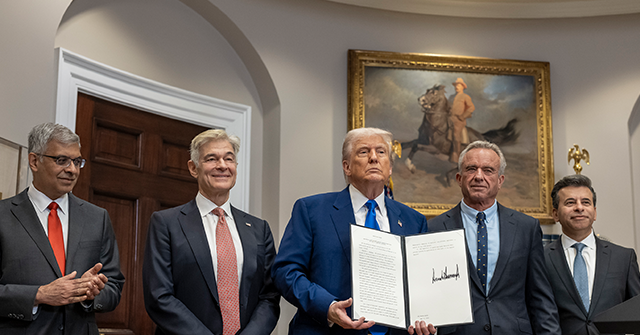Trump’s Drug Price Order Strikes at the Heart of Foreign Free-Riding
For decades, American consumers have been paying the world’s highest drug prices—not because we use more medicine, or demand higher quality, but because our government chose not to negotiate. While other nations imposed hard price caps or demanded steep discounts from pharmaceutical companies, the United States allowed drugmakers to charge whatever the market would bear.
Or so we were told.
In reality, there is no true “free market” in pharmaceuticals. What we call a market-based system is in fact a heavily regulated, government-protected pricing regime built atop patents, FDA exclusivity, and mandatory insurance coverage. It is a system in which competition is deliberately suppressed—first by intellectual property law, then by regulatory lock-in, and finally by federal restrictions that prohibit the country’s largest buyer, Medicare, from bargaining directly. This is not free enterprise. This is cartelized pricing with government enforcement.
The Forgotten Tariff: Prescription Drugs
This divergence took shape in the second half of the 20th century. As Europe and Canada built government-run or heavily regulated health systems, they created agencies to demand steep discounts or block new drugs unless prices aligned with cost-effectiveness thresholds. Meanwhile, the U.S. took a more fragmented, so-called market-driven path.
But how market-driven can a system be when the federal government—through Medicare, Medicaid, and the Veterans Affairs Department—is the largest purchaser of prescription drugs? Medicare, the nation’s largest health insurer, was legally barred from negotiating prices when the Part D benefit was created in 2003. It accounts for around 30 percent of all drug purchases in the U.S. Medicaid’s “best price” rule discouraged deeper private market discounts. And while the U.S. fostered a robust generics industry, brand-name drugs—especially new, high-cost therapies—remained exempt from pricing discipline.
The consequences are staggering. Americans routinely pay two to four times more for the same brand-name drug than patients in Germany, Canada, or Australia. In many cases, the exact same pill made in the same factory costs a fraction abroad of what it does at the U.S. pharmacy counter. These are not generics. These are identical products, sold cheaper everywhere else.
Why? Because every other developed country uses some form of centralized price negotiation or regulation. The U.S. stands virtually alone in letting manufacturers name their price—then requires insurance plans, public and private alike, to cover those products. That is not a market. That is a racket.
Meanwhile, American businesses have shouldered the cost. Rising prescription drug prices inflate the price of employer-sponsored health insurance, raising the cost of labor in the U.S. relative to competitors abroad. Health coverage here is not a government service but an employer obligation. That means every artificially high drug price gets baked into the cost of American labor—and with it, the cost of American goods and services.
By contrast, foreign firms benefit from single-payer systems that negotiate aggressively. Their workers are covered by national health plans; their products aren’t priced with an implicit healthcare surcharge. The result is a quiet but powerful tilt in global competitiveness: a de facto tax on U.S. employment and production.
Global Imbalance by Design
For years, pharmaceutical executives and their lobbyists defended this imbalance by claiming that high U.S. prices were necessary to fund innovation. Foreign governments, they argued, were “free-riding” on American investment. That’s not wrong, but the conclusion is backwards.
If other countries are underpaying, then the solution is not to maintain our overpayment. It is to stop enabling the free ride.
This is not just a healthcare issue—it’s the pharmaceutical equivalent of NATO burden-sharing. For decades, the U.S. has shouldered the cost of defending Europe while European nations underfunded their own militaries. Now, in medicine as in defense, America is demanding that wealthy allies pay their fair share.
President Trump’s Most-Favored-Nation (MFN) Executive Order, signed earlier this month, flips the system. It pegs the prices paid by Medicare and Medicaid to the lowest amount paid by comparable foreign countries. In effect, America will no longer subsidize the rest of the world’s medicine cabinets. If a German patient gets a drug for $300, the American taxpayer will not pay $1,200.
This is not just about domestic affordability. It’s about global competition. For decades, American businesses have shouldered the cost of overpriced prescription drugs through rising insurance premiums and benefit costs. Lowering drug prices isn’t just a healthcare issue—it’s industrial policy.
This policy is also consistent with Trump’s broader trade philosophy. Just as tariffs on foreign steel aimed to correct market distortions created by foreign subsidies, MFN pricing corrects the distortion created by foreign price controls. This is not price fixing—it’s reciprocal pricing. And like tariffs, it is a tool to reassert American sovereignty and strategic interest.
The Innovation Objection
Critics warn that MFN pricing will reduce drug company revenue and thus slow innovation. It may—modestly. The Congressional Budget Office estimates a 5 to 10 percent decline in new drug development over the next two decades. That’s real. But so is the $500 billion in projected savings for American patients and taxpayers.
More importantly, we should ask: What kind of innovation are we funding with those inflated prices? A growing share of pharmaceutical R&D goes toward “me-too” drugs, patent extensions, and market-protection strategies. The idea that every dollar taken from drugmakers is a dollar lost to scientific progress is not just inaccurate—it’s propaganda.
A smarter pricing system may actually sharpen incentives by rewarding genuine breakthroughs while trimming waste. And let’s not forget that public research agencies like the NIH already fund much of the foundational science behind new therapies. The private sector thrives on those publicly created discoveries.
It’s Time for the Rebalancing to Begin
In truth, the MFN order is just a starting point. Its success will depend on implementation, legal resilience, and follow-through in negotiations. But the principle it asserts is clear and long overdue: Americans should not be forced to overpay for medicine so that foreign governments can underpay.
What President Trump has done is extend the logic of America First into a new economic theater: the global drug market. For the first time in modern history, a U.S. president has told the pharmaceutical industry and its international customers that the days of one-way pricing are over. That is not just health reform—it is trade reform. It is industrial policy. And it is a long-overdue assertion of national interest in a sector that has for too long been shielded from scrutiny.
As the administration moves forward, industry backlash is inevitable. So are threats of reduced investment and foreign noncompliance. But as with tariffs, those are not reasons to back down. They are signs the policy is working.
In a global economy rigged by price disparities and state-protected sectors, fairness begins with leverage. The MFN rule is a tool of leverage. And for once, that leverage is being used on behalf of the American patient, worker, and employer—not against them.
The post Breitbart Business Digest: Trump’s MFN Drug Price Plan and the Trade War in Pharma Lab Coats appeared first on Breitbart.




